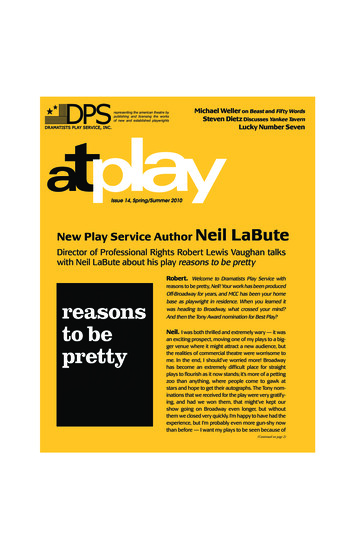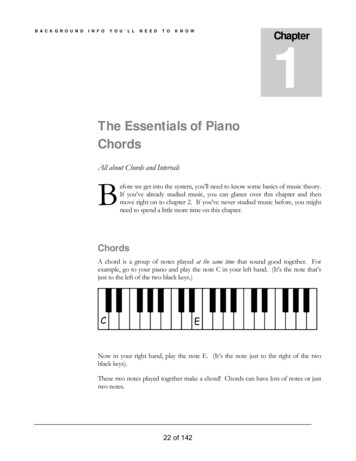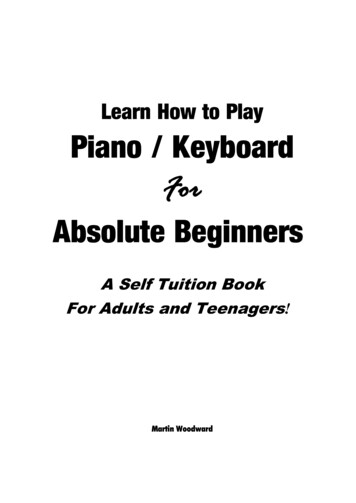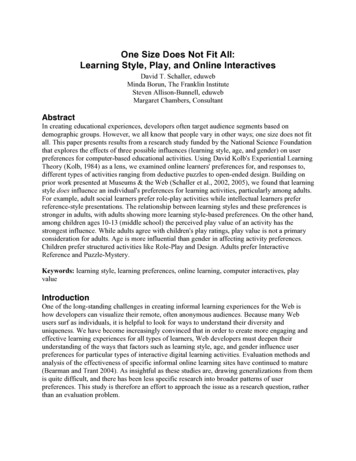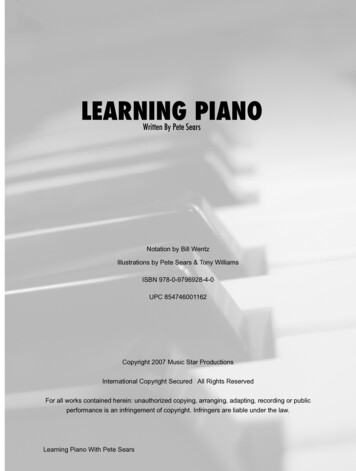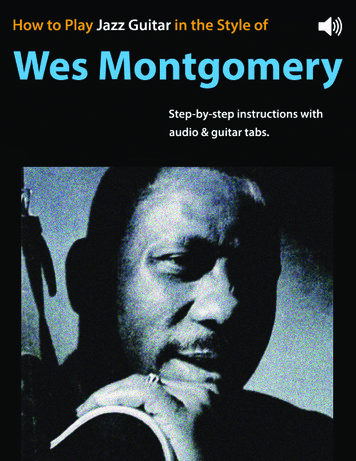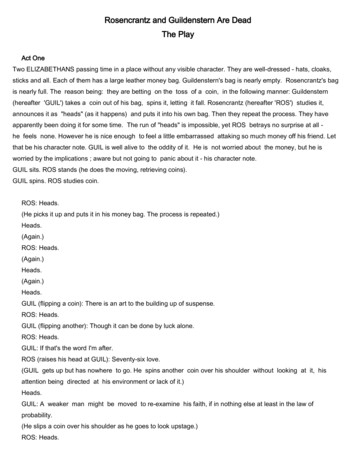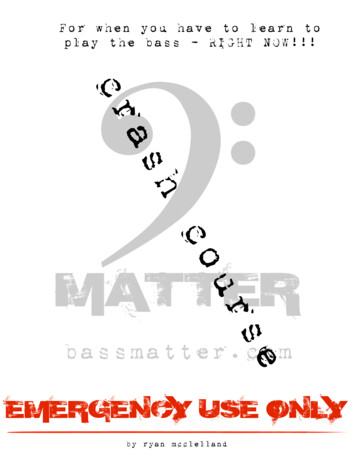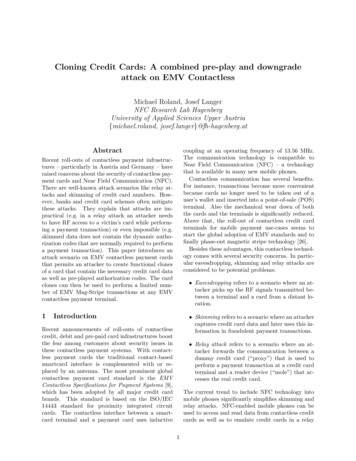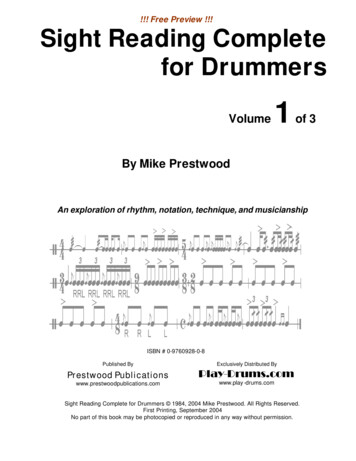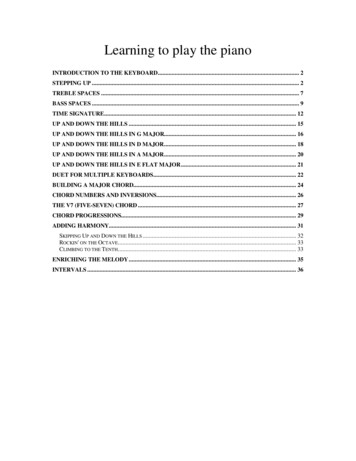
Transcription
Learning to play the pianoINTRODUCTION TO THE KEYBOARD. 2STEPPING UP . 2TREBLE SPACES . 7BASS SPACES . 9TIME SIGNATURE. 12UP AND DOWN THE HILLS . 15UP AND DOWN THE HILLS IN G MAJOR. 16UP AND DOWN THE HILLS IN D MAJOR. 18UP AND DOWN THE HILLS IN A MAJOR. 20UP AND DOWN THE HILLS IN E FLAT MAJOR. 21DUET FOR MULTIPLE KEYBOARDS. 22BUILDING A MAJOR CHORD. 24CHORD NUMBERS AND INVERSIONS. 26THE V7 (FIVE-SEVEN) CHORD . 27CHORD PROGRESSIONS. 29ADDING HARMONY. 31SKIPPING UP AND DOWN THE HILLS . 32ROCKIN' ON THE OCTAVE. 33CLIMBING TO THE TENTH. 33ENRICHING THE MELODY . 35INTERVALS . 36
TION to the KEYBOARDThe keyboard is made up of white keys with repeating patterns of black keys in groups oftwo and three.We use seven letters of the alphabet to make music; A,B,C,D,E,F, and G. After G, westart over again with A.Look at the group of two black keys. C will always be to the left of the two black keys. Ewill always be to the right of the two black keys. And D is right in the middle of the twoblack keys.Now look at the group of three black keys. F will always be to the left of the three blackkeys. B will always be to the right of the three black keys.Each key on the keyboard has a particular tone or pitch, and a certain place on the musicstaff. You will learn how each tone relates to a line or space, and you will be able to findit on the keyboard and combine the notes to make beautiful music.STEPPING UPIf you do not have a musical keyboard near your computer, make a copy of the mockkeyboard as directed on the first page of these lessons. It will be helpful to you inlearning the keyboard.When the notes on the staff go from a line to a space or from a space to a line, we step upor down to the next note letter.In the first measure we begin with the thumb of the right hand on the red-dotted middle C(line). Step up to D (space), then to E (line).In the second measure, the third finger is on E (line). Step down to D (space), then backdown to C (line).This song is written in 4/4 time which means that we count 1,2,3,4 and the black notewith a stem (quarter note) gets one count. The white note with a stem (half note) gets 2counts.2
This song begins with the thumb of the left hand on middle C. In the first measure westep down from middle C (line) to B (space) to A (line). In the second measure, the thirdfinger is on A (line). Step up to B (space), then back up to C (line).Count 1,2,3,4 as you did in the previous song.3
Try this sight reading exercise. First play the right hand alone. Say the names of thenotes. Then play left hand alone and say the names of the notes.Begin with the thumb of the right hand on middle C with a red dot (line). Step up to D(space), then up to E (line), up to the next key F (space) and on up to the next one, G(line). Your 5th finger (little finger) will be on G.G is a white note with no stem. We call this a whole note and it gets all 4 counts in 4/4time. In the 6th measure we have two G's that are white notes with stems (half notes).Each of these notes gets two counts.4
***Begin with the thumb of the left hand on middle C. In the first measure we step downfrom middle C (line) to B (space) to A (line), to G (space) to F (line). Your 5th finger(little finger) is on F in the bass clef.In the second measure, the 5th finger is on F (line). Step up to G (space), then up to A(line), up to B (space) and back up to middle C (line).Count 1,2,3,4 as you did in the previous songs.5
***6
TREBLE SPACESThe treble spaces spell the word "face" F,A,C,E. The first space F is the first F abovemiddle C. The distance from a space to a space is a "skip". You skip a letter when namingthe notes.Your teacher may use a signal to remind you of these notes. Here's one I use. Put youropen palm in front of your face. Rotate it as if washing a window. This will remind youthat the treble spaces spell "face", F,A,C,E.7
To help us remember the treble lines we say, "Every Good Boy Does Fine". The namesof the line notes in the treble are E,G,B,D,F. From one line to the next is a "skip". Westart on the E above middle C (with a red circle) and we skip a letter name as the notesascend, or go up.Our signal for this reminder is the American Sign Language sign for "boy". Pretend youare wearing a cap with a bill on it. Touch the "bill" and move the hand down and awayfrom the face. This sign for "boy" reminds us that "Every Good Boy Does Fine",E,G,B,D,F, the treble lines.8
***BASS SPACESWe remember the bass spaces by saying, "All Cars Eat Gas", A,C,E,G. These are the bassspaces. The A is the second A below middle C (circled in red). We "skip" from space tospace, skipping a letter name in between.Let's learn a signal. Pretend you have a steering wheel in your hands. Turn the wheel asyou "drive". This will remind you that "All Cars Eat Gas", A,C,E,G, the bass spaces.9
***The bass lines can be remembered with "Great Big Dogs Fight Animals" G,B,D,F,A. Thefirst line in the bass is the second G below middle C (circled in red). We "skip" from lineto line, skipping a letter in between to find these new notes.To remember the signal for the lines say "Grrr" like an angry dog. This will help you torecall that "Great Big Dogs Fight Animals", G,B,D,F,A; the bass lines10
***11
TIME SIGNATUREThe time signature, or meter, tells us how to count the music. The top number shows howmany beats to count in each measure. The bottom number tells us the kind of note thatgets one count.If the top number is 4:If the top number is 3:If the top number is 6:There are other meters, but these are the three most common and we will be studyingthose signatures.In the following examples observe that a:a white notewith no stema white notewith a stem12a black notewith a stema black notewith a stemand one flag
This example is in 4/4 time. A whole note gets all 4 beats, a half note gets 2 beats, aquarter note gets 1 beat and 2 eighth notes make one beat.The next example is in 3/4 time. A quarter note gets 1 beat, a half note 2 beats and thedot after the half adds half of the value to the count, so a dotted half gets 2 1 or 3 beats.It takes 2 eighth notes to make a beat.The third example is in 6/8 time. An eighth note gets 1 beat and a quarter note gets 2beats. A dotted half gets all 6 beats (4 2 6).We can raise and lower pitches by putting a sign in front of the note, or by putting sharpsor flats in the key signature which appears at the beginning of each music staff.A sharp raises a note by one-half step (the very next key to the right). The raised notemay be a black key, or it may be a white key, but the sharp will be to the right of theoriginal pitch. In this lesson all sharps will be on the black keys.A flat lowers a note by one-half step (the very next key to the left). It may be a black or awhite key, but in this lesson all flats will be black keys.A natural restores the note to its original pitch without the sharp or flat.13
14
UP AND DOWN THE HILLSWe will learn this exercise first in the key of C Major with no sharps or flats. You willneed to place your hands in the C Major position. The thumb of your right hand will beon middle C and the little finger of your left hand will be on the C below middle C.We will count 1,2,3,4.When you learn the exercise well, you can move your hands up eight notes (an octave)and your teacher or your friend can play the automatic chords which are noted above thestaff. Next a rhythm can be added for more enjoyment. Start out with a metronomemarking of 70 and gradually increase your speed.15
UP AND DOWN THE HILLS IN G MAJORThis exercise is in the key of G Major. There is one sharp in the key signature, but thereare no F's in the song, so all the notes will be on the white keys. You will need to placeyour hands in the G Major position. The thumb of your right hand will be on G abovemiddle C, and the little finger of your left hand will be on the G below middle C.We will count 1,2,3,4.In measures 11, 12, and 15 you will see the D next to middle C written as a leger line, aline added between the treble and bass staff. You find it as you step up from middle C.When you learn the exercise well, you can move your hands up eight notes (an octave)and your teacher or your friend can play the automatic chords and rhythm to accompanyyou.16
This exercise is in the key of F Major. There is one flat in the key signature, and that flatis Bb. Your first B flat will be in the second measure. You will play the black key to theleft of B. You will need to place your hands in the F Major position. The thumb of yourright hand will be on F above middle C, and the little finger of your left hand will be onthe F below middle C.We will count 1,2,3,4.In this exercise you may circle all the B's with a pencil to remind you to flat those notes.When you learn the exercise well, you can move your hands up eight notes (an octave)and your teacher or your friend can play the automatic chords and rhythm to accompanyyou.17
UP AND DOWN THE HILLS IN D MAJORThis exercise is in the key of D Major. There are two sharps in the key signature.In thekey of D Major, all the F's and C's will be sharped. In this exercise the first F# is in thesecond measure. There will be no C's. You will need to place your hands in the D Majorposition. The thumb of your right hand will be on D above middle C, and the little fingerof your left hand will be on the D below middle C.We will count 1,2,3,4.In this exercise you may circle all the F's with a pencil to remind you to sharp thosenotes.When you learn the exercise well, you can move your hands up eight notes (an octave)and your teacher or your friend can play the automatic chords and rhythm to accompanyyou.18
This exercise is in the key of B Flat Major. There are two flats in the key signature, andthose flats are B flat and E flat. You will need to place your hands with the thumb of yourright hand on the B flat to the left of middle C. This is another way to write the B next tomiddle C by using a leger line between the staffs. The little finger of your left hand willbe on the second B flat below middle C. (This fingering is somewhat awkward and wewill learn a better one later.)We will count 1,2,3,4.In this exercise you may circle all the B's and E's with a pencil to remind you to flat thosenotes.When you learn the exercise well, you can move your hands up eight notes (an octave)and your teacher or your friend can play the automatic chords and rhythm to accompanyyou.19
UP AND DOWN THE HILLS IN A MAJORThis exercise is in the key of A Major. There are three sharps in the key signature, andthose sharps are F#, C#, and G#. C# will be used in this exercise, but the other two willnot.You will need to place your hands with the thumb of your right hand on the A abovemiddle C. The little finger of your left hand will be on the A below middle C.There will be notes on the leger lines between the treble and bass staffs. Those notes willbe the D and E right above middle C.We will count 1,2,3,4.In this exercise you may circle all the C's with a pencil to remind you to sharp thosenotes.When you learn the exercise well, you can move your hands up eight notes (an octave)and your teacher or your friend can play the automatic chords and rhythm to accompanyyou.20
UP AND DOWN THE HILLS IN E FLAT MAJORPlay this exercise is in the key of E Flat Major. There are three flats in the key signature,and they are B flat, E flat and A flat. You begin on the black key of E flat. You will useall three of the flats. You will need to place your hands in the E Flat Major position. Thethumb of your right hand will be on E flat above middle C, and the little finger of yourleft hand will be on the E flat below middle C.We will count 1,2,3,4.In this exercise you may circle all the E's, A's, and B's with a pencil to remind you to flatthose notes.When you learn the exercise well, you can move your hands up eight notes (an octave)and your teacher or your friend can play the automatic chords and rhythm to accompanyyou.21
DUET FOR MULTIPLE KEYBOARDSThis first duet can be played on two or more keyboards. There is a first part, Primo (PREmoe), and a second part, Secondo (se KON doe). Each student learns his/her part, thenthey play the parts together, beginning slowly and gradually increasing the tempo.22
Can you play the same exercise in other keys? Remember how we changed our handposition and changed the key when we played "Up and Down the Hills"?When we change the key of a song, we say we transpose the song.Transpose this song to the major keys of G, F, D, B Flat, A, and E Flat.On the keyboard:A half-step is the distance from one key to the next. It may be a white key, or it may be ablack key.A whole-step is made up of two half-steps.A Major Scale if built on a pattern of whole-step, whole-step, half-step, whole-step, whole-step, whole-step, half-step,23
Study and play the C Major scale below. Say the pattern of steps as you play.Right hand fingering: 1,2,3,(thumb under) 1,2,3,4,5.Left hand fingering: 5,4,3,2,1,(third finger over) 3,2,1.BUILDING A MAJOR CHORDIn this lesson you will learn to build a triad. A triad is made of three tones which aresounded at the same time. In the key of C Major, we will build our first triad (chord) onC.Put your left finger on C, and with your right hand count up 4 half-steps. ( A half-step isthe distance from one key to the next. It doesn't matter whether that key is black orwhite.) So we start going up by half-steps; C#, D, D#, E, (1,2,3,4). We have gone up 4half-steps and we are now on E. E is the next note of our triad.Now hold down the E with your left finger and count up 3 half-steps with your righthand; F, F#, G, (1,2,3). You are now on G and G is the top note of the triad.Now play the three notes together; C,E,G. This is the C Major chord or triad inroot position. C is the low (bottom) note of the chord.All major chords in root position will have this pattern of 4 half-steps and 3 half-steps. Ifthe bottom note is on a line, the chord will be line-line-line. If the bottom note is on aspace, the chord will be space-space-space.In another lesson we will learn how to invert or turn the chords around.24
Using the same pattern of 4 half-steps plus 3 half-steps, you can build major chords onany key.25
CHORD NUMBERS AND INVERSIONSWe can build a major chord on each note of the scale. We can use Roman numerals tomark them. If the chord is built on the first note of the scale, we call it a I (One) chord.If the chord is built on the 4th note of the scale, we call it a IV (Four) chord.If it is built on the 5th note of the scale, we call it a V (Five) chord.In C Major, C is the first note of the scale, so we build the I (One) chord on C.F is the 4th note of the scale, so we build the IV (Four) chord on F.G is the 5th note of the scale, so let's build the V (Five) chord on G.After we build the chords in root position, we can change the notes around.Instead of a C,E,G chord, we can put the E as the bottom note and we now have E,G,C asthe tones of the chord. We call this the first inversion of the chord.Put the G on the bottom to make a G,C,E chord and this is the second inversion of thechord.26
THE V7 (FIVE-SEVEN) CHORDWhen you build a V (Five) chord in C Major, the bottom note is G because G is the 5thnote of the C Major scale. We know that the G chord is made up of the notes G,B, and D.Now if you add the 7th tone of the scale, F, you have a nice sound for harmony. We caninvert the chord and sometimes we leave out one of the tones.To move from the I (One) chord to the V7 (Five-seven) chord: keep the top note the same move the middle note up one-half step move the bottom note down one-half step.27
You can now play Mary Had a Little Song using the progression you learned in thislesson.Learn to play the melody of this song with your right hand alone, then you can addchords with your left hand.You will use the C chord to the G7 chord progression.The last note of the song is Low C which is 2 octaves below middle C.The automatic chords are written above the treble staff. Add a rhythm such as a ballad.Begin ver-r-ry slowly with a metronome speed of 60. When you can play it well at thatspeed, then try it faster.28
CHORD PROGRESSIONSIn this lesson we will learn the chord progression I (One), IV (Four), I, V7 (Five-Seven),I.This series of chords if very useful when harmonizing songs.In the key of C Major, the I (One) chord is C,E,G. This is the root position. Play thatchord.Keep the bottom note where it is. Move the middle tone up one-half step, and move thetop tone up two half-steps (one whole step). Now you are playing C,F,A. This is the IV(Four) chord (second inversion).Go back to the I chord in root position; C,E,G.Now move to the V7 (Five-Seven) chord by keeping the top note in place and move themiddle tone up one-half step, and the bottom tone down one-half step, as we learned inthe previous lesson.Now go back to the I chord in root position.First play it with the left hand, then with the right hand, and then with both hands.Play this progression in other keys .29
You can now play America using the progression you learned in this lesson.Learn to play the melody of this song with your right hand alone, then you can addchords with your left hand.Use correct fingering (the numbers between the treble and bass staves) and you will havea smooth melody.If you like, you can play the melody an octave lower beginning on middle C.Add a rhythm such as a ballad. Begin ver-r-ry slowly with a metronome speed of 60.When you can play it well at that speed, then try it faster.30
ADDING HARMONYThere are many different ways to use chords to add harmony to a melody. We will studysome examples and then play the chords in different keys.You will soon be able to tell whether you need a I (One ) chord, a IV (Four) chord, or aV7 (Five-Seven) chord to harmonize with the notes. You may even find new ways to addharmony to your songs.You will learn how to use chords in different ways to harmonize in 4/4 time, 3/4 time,and 6/8 time.Oom Pah in 4/4 TimeUse this simple "Oom Pah in 4/4 Time" for many melodies. Use the three notes of the CMajor triad to create an "Oom Pah" with the left hand.31
Skipping Up and Down the HillsWe can use "Skipping Up and Down the Hills" in 4/4 time. Use the Major triads to play anote on each beat of the measure.32
Rockin' on the OctaveWhen "Rockin' on the Octave", play the root, the 5th, the root note an octave higher, andback to the 5th.Climbing to the Tenth"Climbing to the Tenth" makes a nice harmony. You could also use it in a 3/4 time.33
Oom Pah Pah in 3/4 TimeUse this pattern to add harmony to songs written in 3/4 or waltz time. Try it with HappyBirthday or My Country Tis of Thee .Broken Triads in 6/8 TimeUse these broken triads to harmonize songs in 6/8 time.34
Oom Pah Pah in 6/8 TimeUse this pattern for 6/8 Time. The quarter note will get two beats and the eighth note onebeat.Enriching the MelodyUse this method to make the melody sound fuller. Add some chords in differentinversions with the melody as the top note of the chord.35
INTERVALSAn interval is the distance from one tone to the next. We refer to intervals with ordinalwords such as second, third etc.We will be learning about major intervals. You will learn to hear them, play them, andsing them.First you need to learn to play and sing the C Major scale. Sing 1,2,3,4,5,6,7,8.(Click on the speaker to hear the C Major scale.)36
SECONDFrom C to D is the interval of a 2nd. These are the first two notes when you sing Doe, adeer, a female deer. from the Do, Re, Mi song. Play and sing the interval of a second.THIRDFrom C to E is the interval of a 3rd. E is the middle tone of a major chord. Play thischord: C,E,G,E,C, and sing 1,3,5,3,1. You hear the 3rd when you sing 1,3 . Play and singthe interval of a third.FOURTHFrom C to F is the interval of a 4th. You hear this interval when you sing I've been working on the Railroad Play and sing the interval of a fourth.FIFTHFrom C to G is the interval of a 5th. Listen for this interval when you sing Twinkle,twinkle little star. Play and sing the interval of a fifth.SIXTHFrom C to A is the interval of a 6th. This is one tone above the 5th. You can find the 6thby singing Old McDonald had a farm, E, I,E,I,O From "farm" to "E" is a 6th. Play andsing the interval of a sixth.SEVENTHFrom C to B is a 7th. This is a hard one to find and sing. Practice singing a 7th.EIGHTH (OCTAVE)From C to C is the interval of an octave. This is the same tone eight notes higher. Whenyou are singing the Happy Birthday song and you get to the part Happy birth- day dearSo-and-So, the octave is the "happy, birth-". Play and sing the interval of an octave.37
keyboard as directed on the first page of these lessons. It will be helpful to you in learning the keyboard. When the notes on the staff go from a line to a space or from a space to a line, we step up or down to the next note letter. In the first measure we begin with the t
